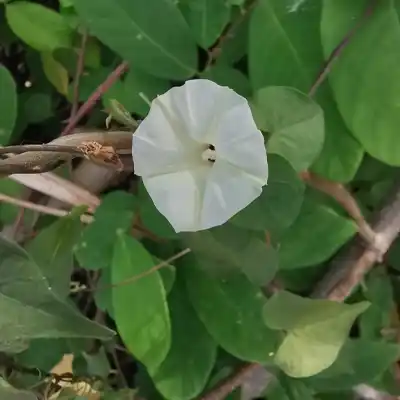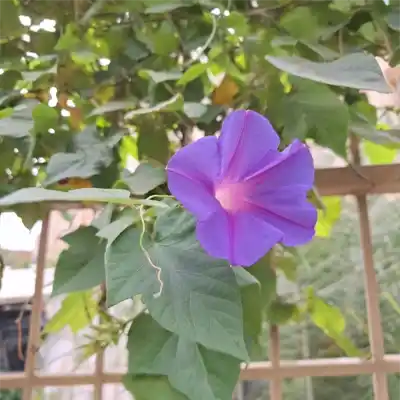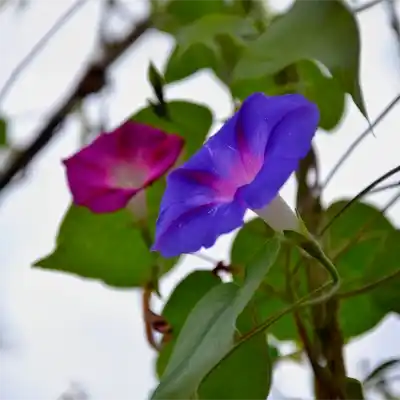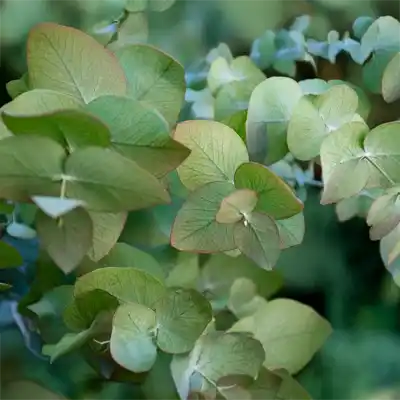Untangling Indiana Vines:
Identifying Bindweed, Morning Glory, & Honeyvine Milkweed
Few things can overwhelm a garden or landscape faster than invasive or fast-spreading vines. Some vines, such as morning glory, are planted intentionally for their beauty. Others, like bindweed or honeyvine milkweed, sneak in uninvited and quickly take over, smothering flowers, shrubs, and even trees. For homeowners in Indiana, identifying these vines correctly is the first step toward managing them.
At Wells Lawn Care, we often see homeowners struggling with three confusing yet common vines: bindweed, morning glory, and honeyvine milkweed. At first glance, they appear similar—fast-growing, heart-shaped leaves, and climbing habits—but their traits, impacts, and management strategies are very different. This guide breaks down how to identify each vine, understand its role in your yard, and decide the best way to manage it.
Bindweed in Indiana

Appearance & Traits
Bindweed (Calystegia sepium or Convolvulus arvensis) is one of the most persistent weeds in Indiana. This perennial vine has arrowhead-shaped leaves and produces small white or pink funnel-shaped flowers. While delicate-looking, bindweed spreads aggressively through rhizomes and underground stems that form dense colonies and are extremely difficult to remove once established.
Two species are most common: hedge bindweed and field bindweed. Both are aggressive, but field bindweed is especially problematic it’s listed as a prohibited noxious weed in Indiana. That classification highlights just how invasive and destructive this plant can be if left unmanaged.
Why It’s a Problem
Bindweed quickly entangles everything in its path, shrubs, fences, and even lawns. Because it spreads underground, simply pulling the vines rarely solves the problem; new shoots emerge from any roots left behind.
Over time, bindweed can starve nearby plants of sunlight and nutrients, leaving landscapes messy and unhealthy.


Control & Management
Cultural control methods, such as repeated cultivation, mulching, or blocking light, can take years sometimes three to five seasons to show results.
Herbicide applications, when carefully timed, may improve control. However, because bindweed is such a determined survivor, homeowners should be prepared for a long-term management plan.
Morning Glory in Indiana

Appearance & Traits
Morning glory (Ipomoea spp.) is often admired for its showy, funnel-shaped flowers. Unlike bindweed, morning glory is an annual plant, dying off in winter. However, its prolific seed production means it often comes back year after year. A single vine can produce thousands of seeds that remain viable in the soil for decades.
In Indiana, two main types are common:
- Common morning glory (Ipomoea purpurea): Large, heart-shaped leaves and colorful flowers ranging from purple and blue to pink and white.
- Ivy-leaf morning glory (Ipomoea hederacea): Three-lobed leaves resembling ivy and smaller flowers, typically blue or purple with white centers.
Why It’s a Problem
Though often planted intentionally, morning glories can become weedy if not managed carefully. A single vigorous vine can quickly cover fences, trellises, or nearby plants, creating a tangled mess. Left unchecked, morning glories will reseed and spread throughout your landscape.
Control & Management
The key to controlling morning glory is containment. Plant them in intentional spaces like trellises or fences, prune back excess growth, and remove seed heads before they drop. Deadheading, the removal of spent flowers, can reduce reseeding and help keep the vines under control.

Honeyvine Milkweed in Indiana

Appearance & Traits
Honeyvine milkweed (Cynanchum laeve) is a native Indiana vine that often gets confused with bindweed or morning glory. Like bindweed, its leaves are heart-shaped but the difference lies in their arrangement. Honeyvine leaves grow opposite each other along the stem, while bindweed and morning glory have alternating leaves.
Honeyvine milkweed produces clusters of small, greenish-white flowers and long pods filled with silky, windblown seeds.
Why It’s a Problem
Though native, honeyvine milkweed can grow aggressively and overwhelm landscapes if not managed. It climbs fences, trees, and shrubs, forming dense tangles that may crowd out other plants.
Ecological Benefits
Unlike bindweed, honeyvine milkweed offers ecological value it serves as a host plant for monarch caterpillars and provides nectar for pollinators. While beneficial in naturalized areas or pollinator gardens, honeyvine may not be welcome in manicured landscapes.


Control & Management
Homeowners often choose to allow honeyvine in designated pollinator zones while removing it from lawns or garden beds. Controlling spread involves pruning, removing seed pods before they open, and keeping growth confined.
Take Control of Vines in Your Yard
At Wells Lawn Care, we know Indiana vines can be tricky; some need to be removed, others contained, and a few supported for pollinators.
Our team can help you find the right balance while keeping your lawn and landscape looking clean, healthy, and beautiful.
Contact Wells Lawn Care today to schedule your vine management consultation!
Managing Vines in Indiana
Correct identification is the key to effective management. Some vines need to be removed completely, others are best contained, and a few should be supported for their ecological benefits. For many homeowners, knowing which approach to take and following through effectively can be a challenge.
That’s where Wells Lawn Care comes in, offering expert services to keep your yard healthy, attractive, and easy to maintain.

Weed Control

Seasonal Cleanups
Remove unwanted growth and debris to keep your yard neat, healthy, and ready for the next season.

Landscape Maintenance
Quick Tips for Identifying Indiana Vines
Because bindweed, morning glory, and honeyvine milkweed can look so similar, here’s a simple guide to help distinguish them:
- Leaf Arrangement:
- Alternating leaves → bindweed or morning glory
- Opposite leaves → honeyvine milkweed
- Flowers:
- Small white/pink funnels (1–3 in) → bindweed
- Large colorful funnels (2–4 in) → morning glory
- Small greenish-white clusters → honeyvine milkweed
- Seed Pods:
- Small capsules → bindweed or morning glory
- Long pods with silky seeds → honeyvine milkweed

The Bottome Line on Indiana Vines
Bindweed, morning glory, and honeyvine milkweed may look alike, but they behave very differently in Indiana landscapes.
Correct identification is the first step toward deciding whether to remove, contain, or encourage these fast-growing vines. With help from Wells Lawn Care, you can protect your yard from invasive weeds, support pollinators, and keep your landscape looking its best year-round.
Ready to create your dream garden or maintain your current landscape? Contact Wells Lawn Care or explore our Monthly Packages to get started!
